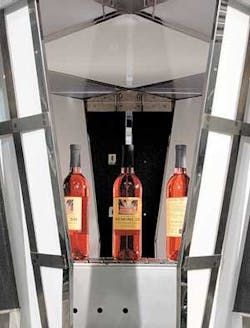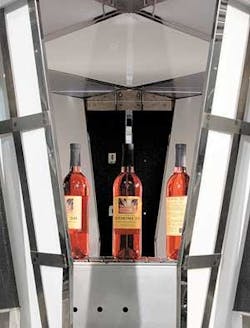Machine vision targets label inspection
Andrew Wilson, Editor, [email protected]
Since the 1950s, ICS Inex Inspection Systems (Clearwater, FL, USA; www.icsinex.com) has supplied packaging vendors with automated systems for the inspection of bottled beverages. At PackExpo (Las Vegas, NV, USA; September 2005), the company introduced its latest noncontact label-inspection system, the Gemini 3D, designed to operate at speeds to 600 containers per minute.
Using multiple cameras, the system captures label details and performs inspection of the entire label on a single unwrapped image. By inspecting containers without prior orientation, the Gemini 3D eliminates a costly step from the inspection process and allows inspection of products with multiple labels and graphics from the container base to the top seal.
“By removing the inspection process from the labeler, we have eliminated the risk of adhesive and paper dust contamination that can foul camera lenses and create false rejects,” says Mike Lawn, ICS Inex director of applications engineering. Built to “drop in” on existing conveyors, the Gemini 3D has a footprint of 37 × 37 × 65 in. that includes the inspection station and reject device mechanism.
“In designing the system,” says Lawn, “we realized that we needed to capture multiple views of the containers as they move along the production line.” To do this, four independent high-resolution analog cameras were placed at 45° within the Gemini 3D housing (see photo). “This ensures that a complete image of the label is obtained no matter what the label orientation. After images are captured they are digitized by a proprietary, PC-based frame grabber that unwraps, registers, and restitches the four images.
“After images are unwrapped,” says Lawn, “specific parameters of each label are compared with a golden template that has been ‘learned’ by passing a known good label through the machine.” To compare captured labels with this template, machine-vision software tools perform functions such as label location, pattern-matching, and barcode analysis. New tools were developed for specific inspection of label edges. Additionally, the architecture of these tools enabled the applications to interface to third-party components for process control, I/O, and machine control via Ethernet.
“This was especially useful in the design of the Gemini 3D system, since three independent PCs, each linked via Gigabit Ethernet, were used to perform the machine vision, system management, and systems setup/graphical user interface (GUI) functions,” says Lawn. After images are analyzed, the results of each inspection are sent to a second PC.
“This PC is responsible for monitoring the line sensor used in the system and assigning a specific identification to each bottle as it passes through the inspection station,” says Lawn. Since the vision system can read specific product numbers on each bottle, this information can be correlated with the identification number and be used to track the container though the system. Should a bottle or container be defective, the second PC actuates the reject mechanisms further along the production line.
In developing the GUI, ICS Inex chose to implement a Windows-based user interface with an LCD touch screen running on a third PC for setup and operation of the Gemini 3D. “With the autolearn feature, operators can set all key product parameters by passing a correct sample through the machine. Because the same inspection tasks that run on the vision engine run on this PC,” says Lawn, “the operator can fine-tune production parameters during operation to accommodate minor variations in product attributes. This also allows specific machine parameters to be changed before they are implemented on the vision engine.”

